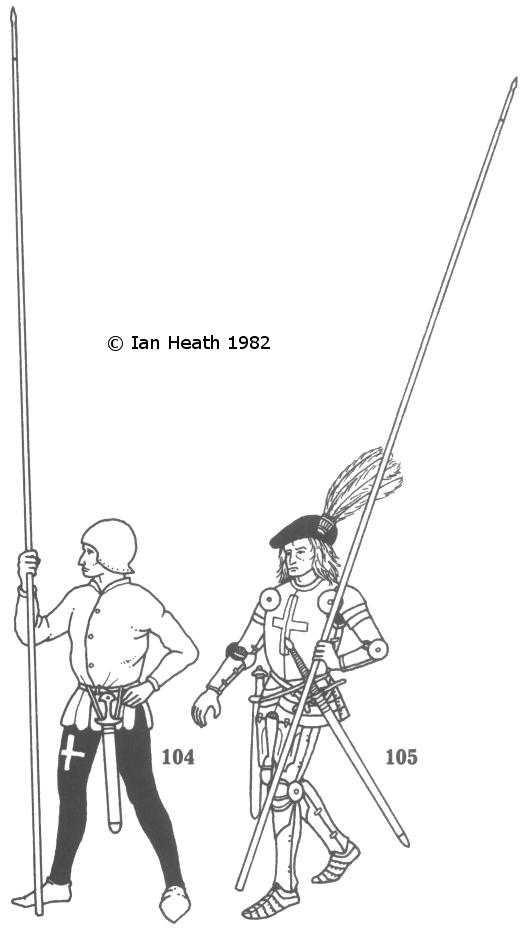
Shop Amazon - Create an Amazon Baby Registry

SWISS PIKEMEN, 15th CENTURY
An extract from Armies of the Middle Ages, volume 1by Ian Heath


104 & 105. SWISS PIKEMEN, 15th CENTURY
These figures graphically illustrate the two extremes of Swiss equipment that were to be found alongside one another during the 15th century.
104 comes from a picture of the St Jacob-en-Birs campaign of 1444. He wears no armour other than a sallet of North Italian type, and other than his pike carries only a wooden-handled Schweizergegen, a characteristically Swiss weapon that was a cross between sword and dagger. Pikemen being chiefly supplied by the lower classes, it was not uncommon for them to wear little or no armour; indeed, in 1476 an entire Confederate army of 6,000 men was apparently entirely unarmoured. Nevertheless, captured enemy armour was pressed into service whenever available.
Regarding his dress, readers familiar with Renaissance period Swiss costume will notice that both here and in all of the following late-15th century illustrations the normal High Gothic fashion of tight hose and short jacket, universal throughout most of Europe, is still followed. However, the sweeping changes in fashion that occurred towards the end of the century were a direct result of the victories of the Swiss over the Burgundians, for they appear to have thereafter donned their victims' looted clothing, which was either already soiled or which they themselves slashed where necessary in order to make it fit - the origin of the brightly-coloured, puffed, slashed European costume that prevailed for much of the 16th century. This fashion of dress was already well-established by c. 1490, by which year tailors had actually begun to manufacture clothes to this new style, 'learning this art of slashing' as one contemporary sourly observed.
The white cross evident on both of these figures is first recorded in use among the Swiss at the Battle of Laupen in 1339. Some contemporary or near-contemporary pictures show crosses on armour in black, blue or red, presumably to show up against the metal (though such darker crosses also sometimes appear on ordinary clothes too). Since the cross could not be painted on mail as it was on plate armour, mail corselets instead had a cross-bearing cloth escutcheon sewn on chest and back. Interestingly the cross is more often worn on the thigh than on the body in most contemporary illustrations, probably because where armour was worn it was more often than not only half-armour like that of 103, thus leaving the legs exposed; it was worn on either left or right leg, whichever was the darker (striped or parti-coloured hose being the norm) or sometimes on both legs.
Figure 105, from Schilling's 'Berne Chronicle' of c. 1485, unusually wears leg-harness, being an officer (such armoured men riding to battle while the rest marched). He wears a red bonnet with a green/red/white/blue plume, such tall plumes of 2-4 feathers apparently being much favoured, in particular amongst officers and standard-bearers. These plumes were frequently in cantonal colours for example, another Schilling picture shows the standard-bearers of Zug, Unterwalden, Uri and Lucerne with white/blue/white, red/white, yellow/brown/yellow and blue/white feather combinations respectively. Some officers and standard-bearers of this period appear to have in addition worn a coloured sash diagonally across the chest, this too being decorated with several white crosses.
The Swiss pike of the Burgundian Wars period was probably still only 12-15 feet in length, but there seems to be general agreement among historians that it had been lengthened to 15-18 feet by the late-15th century. The 18-foot pike itself did not actually originate in Switzerland but in Italy, being first made in Turin in 1327. The first use of the pike in great numbers by the Swiss is recorded in 1425, principally, as already observed, as a direct result of their experience at Arbedo.
The long-handled sword of 105 occurs in all the late-15th century Swiss sources, though it is invariably depicted wielded in only one hand. It is sometimes shown suspended from a baldric rather than girded at the waist.